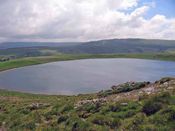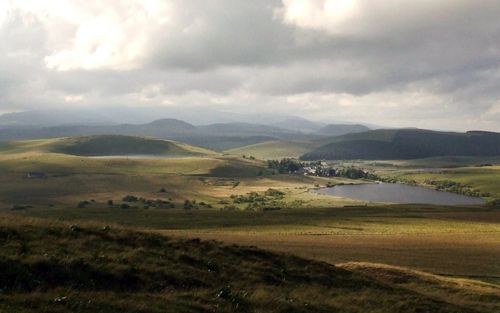 La Godivelle is a small village located in the Cézallier Massif, up south the Dore Mountains, about 70km up south Clermont-Ferrand. It is part of the Auvergne Regional Volcanic Nature Park. La Godivelle is both the uppermost and the least populated commune in the department. There are 2 Lakes in La Godivelle – the Upper and the Lower.
La Godivelle is a small village located in the Cézallier Massif, up south the Dore Mountains, about 70km up south Clermont-Ferrand. It is part of the Auvergne Regional Volcanic Nature Park. La Godivelle is both the uppermost and the least populated commune in the department. There are 2 Lakes in La Godivelle – the Upper and the Lower.
The Upper Lake is a crater lake located at 1239 meters of altitude. It was shaped by a volcanic eruption. It explains why it is a round lake and 44 meters deep. It provides water supply in the village. It is one of the most oligotrophic lakes in Europe, meaning it is deficient in plant nutrients.
The Lower Lake is a glacial lake located at 1200 meters of altitude. It constitutes a bog with the Lake of Saint-Alyre.
La Godivelle Nature Reserve – Réserve Naturelle des Sagnes in French – includes the 2 Lakes. The Reserve was created in 1975 in order to protect and conserve the peat bog, which is a fragile habitat. There, you can see carnivorous plants like sundews and butterworts. You can also observe diving spiders; these spiders build underwater diving bell webs which are filled with air, they live within their webs. Diving spiders can bite you with their chelicerae – their mouth appendages – if they feel attacked; the bite is not dangerous though. There are also other arthropod species living in this peat bog of special scientific interest.
Here is the story of the 2 lakes as published in the Auvergne Regional Volcanic Nature Park’s website.
The landscape you can see today started to take shape more than 10,000 years ago, when the last glaciers started to melt down because of warmer climate. Numerous lakes were created, some of which have progressively turned into peat bogs. In this way, the “Coualle Basse” is a former lake which has been filled by flora. The Lower Lake covered 50 hectares before and 10 hectares now. The flora has invaded the southern part of the lake; trees have begun to cover the peat bog.
Though the Lower Lake is a young (10,000 years old) glacial lake, the Upper Lake is much more different. It is an 113,000 year-old crater lake, 44 meters deep, it covers 15 hectares and has a 300-meter 300 diameter. It is nestled in a basaltic maar.





